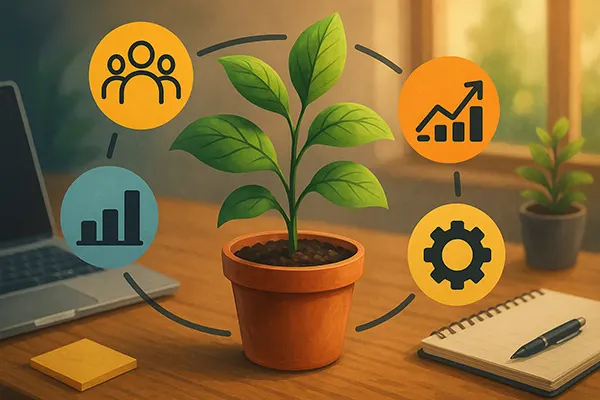
How a Startup Can Build an Internal Growth Ecosystem Without External Funding
In 2025, when access to venture capital is tighter and investor expectations have risen, startups are increasingly turning to sustainable self-growth strategies. Building an internal growth ecosystem is no longer a romantic notion but a pragmatic response to economic uncertainty. It means using internal resources, customer value, and operational efficiency to drive expansion — without relying on external capital injections.
Developing Value from Within
Creating internal value begins with a sharp focus on customer needs and consistent feedback loops. Startups that invest time in understanding their audience and refining the product-market fit can sustain long-term growth without investor dependency. For instance, the British company Basecamp refused to take large external investments, focusing instead on steady subscription income and building customer loyalty through simplicity and service quality.
Internal growth also depends on organic brand building. Teams that align around a shared mission and create genuine connections with users gain stability that advertising cannot buy. Companies such as Mailchimp have demonstrated that authenticity can drive market dominance, maintaining profitability for years before any acquisition was considered.
Finally, nurturing in-house talent plays a crucial role. When employees are encouraged to experiment, learn, and optimise, they become the engine of innovation. Internal workshops, peer mentoring, and small cross-functional projects often lead to product improvements that significantly enhance customer retention.
Case Studies of Sustainable Growth
Mailchimp’s founders famously avoided venture capital, choosing to reinvest revenue into research and development. Their autonomy allowed them to prioritise customer satisfaction over investor returns, eventually resulting in a billion-dollar valuation. Similarly, the Danish startup Airtame, developing wireless screen-sharing tools, grew through direct sales and user feedback rather than external capital, achieving profitability by prioritising product usability and education-sector partnerships.
Another example is the London-based company Monzo during its early phase. Before major funding rounds, Monzo relied heavily on a community-driven model. Beta users acted as brand ambassadors, spreading awareness through word of mouth — a cost-effective marketing approach that amplified loyalty and engagement.
These examples underline that growth without external funding is not about austerity, but about mastering balance — prioritising efficiency, reinvestment, and sustainable scaling over rapid, unsustainable expansion.
Choosing a Sustainable Monetisation Model
The monetisation model is the foundation of a self-sustaining ecosystem. Startups must prioritise models that ensure predictable cash flow and repeatable revenue streams. Subscription-based services, tiered memberships, and freemium approaches allow gradual customer growth while maintaining financial stability. Profit margins improve as operations scale internally.
Some founders adopt hybrid approaches, combining one-time purchases with long-term service contracts. This balance stabilises income while maintaining flexibility for reinvestment. For example, software startups in 2025 often introduce modular pricing — where users pay only for the features they need — improving satisfaction and lowering churn rates.
Additionally, partnerships and affiliate programmes can serve as non-financial levers of growth. Collaborating with other startups or local businesses creates exposure and revenue-sharing opportunities without direct financial expenditure. Strategic alliances allow mutual benefit in visibility and resource sharing.
Optimising Costs and Operations
Internal ecosystems thrive on lean operation principles. Automation of repetitive tasks — accounting, customer service, or analytics — saves both time and cost. Tools like Zapier, Notion, and AI-driven dashboards empower teams to scale without additional hires, maintaining agility and efficiency.
Startups should also adopt a “profit-first” mindset. Instead of focusing on gross revenue growth, founders should track profitability ratios, recurring customer value, and operational efficiency. This mindset encourages data-driven decision-making and protects the company from unnecessary debt or dilution.
Finally, decentralised decision-making empowers small teams to act quickly. When employees understand how their work contributes to profit and sustainability, they naturally make cost-conscious and value-focused decisions, further strengthening the internal growth loop.

Building a Culture of Internal Growth
The strongest ecosystems rely on culture — not capital. A company that celebrates transparency, accountability, and shared purpose encourages natural growth. Employees become stakeholders in success, motivated by results rather than external validation. Clear communication channels and goal alignment make even small teams highly effective.
Learning and adaptability are vital. Startups that embrace data-backed experimentation can pivot without panic, transforming challenges into insights. Encouraging teams to measure impact rather than activity ensures that every effort directly contributes to sustainable progress.
Finally, internal culture must prioritise customer-centric thinking. Teams that understand the long-term value of trust and service excellence cultivate a loyal user base. In 2025, trust is currency — and those who build it internally, rather than buying it through advertising, will thrive in the evolving startup landscape.
Long-Term Vision and Resilience
Startups that grow from within are naturally more resilient. They respond to market volatility with agility, relying on internal innovation rather than investor directives. This autonomy strengthens their long-term competitiveness and fosters genuine brand integrity.
Self-financed startups also tend to attract talent who value stability and purpose over speculation. Their culture becomes an asset, not an afterthought, ensuring that even in downturns, morale and creativity remain intact.
Ultimately, the internal growth ecosystem model is about independence — creating a self-sustaining cycle where value generation, reinvestment, and learning continuously feed one another. It’s not just a funding strategy, but a philosophy of sustainable entrepreneurship for the modern era.
Popular articles
You may be interested in related articles.
-
Expanding a startup into a new geographic market is a milestone that …
More -
In 2025, when access to venture capital is tighter and investor expectations …
More -
Decentralised ownership is redefining how startups attract investments and distribute equity. As …
More -
The Central and Eastern European (CEE) region has become increasingly attractive for …
More



